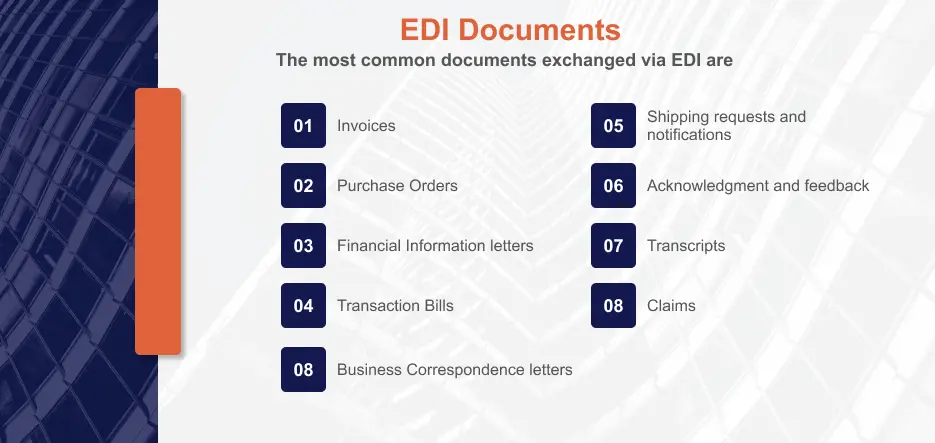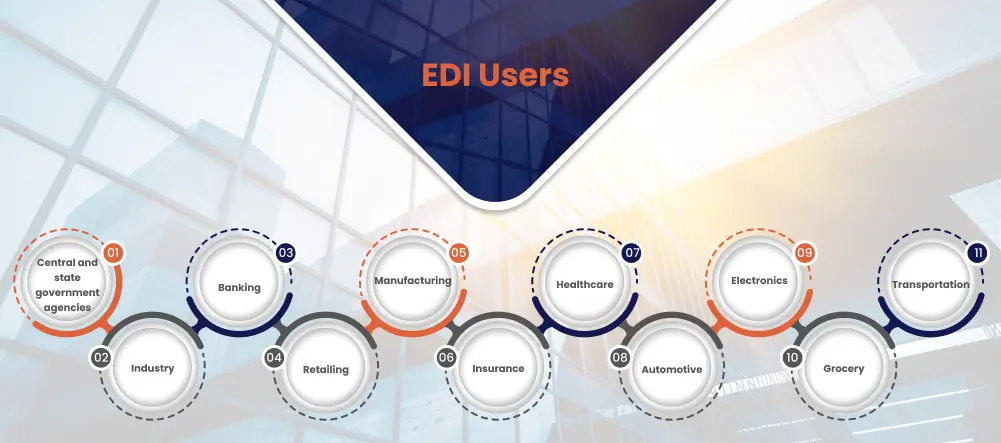Automating business-to-business (B2B) communications, EDI, or electronic data interchange, is a technology that enables trading partners and organizations to get more done, expedite logistics schedules, and do away with manual errors. From manufacturing and transportation to purchasing and selling of items, service providers like manufacturers, retailers, logistic companies, airlines, insurance providers, health providers, and so on, leverage EDI services for their business.
A Forrester study claims that EDI transactions are above 20 billion yearly and still rising. Seven trillion dollars, or 78.9%, of all B2B electronic sales in 2019 came from EDI, according to data analysis research in the 2020 B2B E-commerce Market. EDI, already here since the 1960s, is getting renewed interest today. Because it helps enable digital transformation, workflow automation, and business processes, including supply chain automation.
Defining EDI and how does it work?
Electronic data interchange is the automatic exchange of commercial documents among businesses. Interchange of paperwork like purchase orders, shipping forms, and invoices is necessary for day-to-day commercial operations. Company personnel typically share paper-based papers or emails with attachments, which they subsequently manually process and enter into their business data systems. These processes are automated using EDI technology, allowing digital systems to share and process documents across corporate boundaries without the need for human intervention. IT systems can be linked to other systems in a business-to-business (B2B) network by organizations to minimize processing errors and save time.
The methods that EDI software solutions use to safely move data from one computer to another are called EDI protocols. Every protocol is based on a set of global standards that specify how the data is encrypted and set up during transmission. There are many EDI messaging protocols developed. These are made to deliver and receive data using various EDI software solutions and data exchange technologies.
EDI was founded in 1968 by a bunch of firms. The protocols have evolved over more than 50 years. In some cases, new protocols have been introduced every few years to take advantage of emerging technologies. Let us look at different types of EDI protocols available –
- Direct vs. VAN
- AS1
- AS2
- AS3
- AS4
- FTP
- OFTP
- Web EDI
- Mobile EDI
Achieve Compliance & Efficiency With Our EDI Solutions
How does EDI work?
The two main modes of transmission that EDI uses are:
- Two business systems are connected by a point-to-point or direct EDI connection using secure protocols.
- A third-party network that manages the data transmission process is used in the value-added network (VAN) approach.
A mailbox concept is frequently used by EDI software to enable batch processing and document interchange. EDI documents are transmitted via secure internet protocols like Simple Object Access Protocol (SOAP), Secure File Transfer Protocol (SFTP), and HTTPS-based protocols like AS2. Furthermore, good data quality in EDI transactions is made possible by communication standards that are managed by many organizations, including Peppoi, ODETTE, and the Accredited Standards Committee X12. These EDI standards guarantee a minimum degree of data governance.
To provide the document with more context, EDI software can also merge two or more data segments. To fully describe the products and quantities in order, for instance, EDI can combine the data components ITEMQUANTITY and ITEMDESCRIPTION into ORDERLINE. Combinations of data offer more context and simplify the EDI document structure.
Types of EDI
Depending on the parties transferring the information (typically financial data and related documents) and the business use case, there are several ways that EDI services can take place.
1. Direct EDI
Point-to-point EDI, also known as direct EDI. This establishes a single connection between two business partners. With this system, users establish distinct connections with each business partner. It is most commonly used between large consumers and suppliers who carry out several daily transactions, giving power to business associates.
2. EDI enabled by Value-Added Network (VAN)
The EDI service providers, also referred to as a value-added network (VAN), is an alternative to the direct EDI framework and was operational long before the internet.
Many firms choose this network model because it protects them from the constant hurdles of keeping up with the multiple EDI communication protocols that different business partners require. Private networks known as VANs are used by partners to exchange electronic commercial papers. In addition to managing the network, the VAN provider sets up mailboxes for enterprises so they may send and receive EDI documents.
3. Applicability Statement 2 (AS2)-enabled EDI
AS2 is a network communications protocol that enables safe data transfer via the Internet. It is made up of two computers that communicate point-to-point across the internet: a client and a server. Using digital certificates or encryption, AS2 creates an “envelope” for EDI data that allows for safe internet transmission. Everyone can readily access this form of EDI services.
4. Web EDI
The method of performing an EDI transaction over a web browser is known as web EDI. It is an online form that looks like paper documents. Sections for information entry will be included in the form. Following the provision of the necessary data, the document is converted instantaneously into an EDI message and transmitted using secure internet protocols, such as AS2, HyperText Transport Protocol Secure (HTTPS), or File Transfer Protocol Secure (FTPS).
5. Mobile EDI
In the past, users have sent and received business papers about EDI across a network, such as the Internet or a VAN. Security issues and restrictions on screen quality or device size have limited the use of mobile EDI apps. However, a growing industry is developing EDI apps that can be downloaded on mobile devices. Mobile EDI applications are available, for instance, through Oracle’s JD Edwards EnterpriseOne.
6. Outsourced EDI
Businesses can engage outsourced EDI environment management specialists thanks to a rapidly growing solution called EDI outsourcing, often known as managed EDI services. The necessity for enterprises to integrate with back-office business systems, such as integrating EDI with ERP, is one factor driving this. This is advantageous because a lot of companies dislike dedicating internal resources to the ongoing and monotonous EDI transaction chores.
7. Indirect EDI
The exchange of information via EDI consultants or value-added network between an ERP and clients, suppliers, or third-party logistics service providers (3PL) is known as an indirect EDI transaction. The message is initially transmitted from the ERP to the broker or VAN, along with all the information you desire from your business partners. The EDI consultants then deliver the communication to the appropriate parties after dividing it into different formats based on the preferences of your vendors or customers.
The Primary EDI Standards
Trading partners have to share the same standard format software for the original EDI implementations to work, and the four most popular ones are still:
- The United Nations created the widely used worldwide standards known as UN/EDIFACT (United Nations/Electronic Data Interchange for Administration, Commerce, and Transport) in 1987.
- Mostly utilized in North America, ANSI X12 (Accredited Standards Committee X12) was first introduced by the American National Standards Institute in 1979.
- EDIFACT’s renowned recent development, GS1 EDI, is utilized in numerous international supply chains.
- VDA: One of the more recent EDI standards, VDA has gained popularity quickly and has extensive usage in the German automotive sector.
PEPPOL (Pan-European Public Procurement Online) is another widely used standard. The inclusion of a “communication standard” using the same name makes PEPPOL an especially intriguing development. In Europe, PEPPOL is widely used, especially in the public sector. PEPPOL has been in use by the NHS in the UK since 2019.

Electronic Data Interchange Implementation
The three primary phases of EDI implementation for business document processing are as follows.
Create the infrastructure
A business must first purchase and install the necessary EDI gear and software. These elements oversee the mapping of pathways, transmission, integration, and translation of EDI documents. Any company papers are transformed into a suitable format thanks to EDI software. Typical software elements consist of:
- Software for EDI mapping that converts file data, like names and addresses, into standardized documents
- Software for batch enveloping and de-enveloping transactions allows senders and recipients to accept, wrap, and unravel messages.
- Software for message routing to send messages, transport them to the right recipient addresses, and guarantee that the message’s format is appropriate for the intended receiver
- Setting up and connecting to VANs, which offer dependable and secure transfer paths, is typically another phase in this process. Make sure you have the necessary gear, such as servers, network equipment, and storage, if you wish to manage EDI internally.
Make Ties
After setting up your EDI system’s technological framework, you need to establish communication with your business partners. With these trading partners, you’re processing and exchanging documents, thus you need to adopt EDI standards that make the connection safe and secure.
Certain locations and sectors may have a preference for a particular EDI standard format. To make it easier to exchange EDI documents, you can set up your EDI system to use the same standards as your trading partners. Setting up the VPNs, firewalls, or AS2 connections required to guarantee a secure data transfer method is also included in the configuration.
Follow the rules
Your EDI system needs to follow the rules and guidelines for data protection set forth by your industry. To stay in compliance, you must modify your system if any of the standards you use are updated. If your trading partners choose to modify the standards they adhere to, you also need to be aware of these changes and prepared to make adjustments.
We Help You With Customized EDI Solutions To Boost Your Business Performance
Benefits of EDI
EDI has been revolutionizing various industries for decades now. Let’s take a look at the different benefits of EDI–
Automate Procedures
Claims processing no longer needs human interaction thanks to EDI implementation. Every procedure related to the revenue cycle is automated.
Automation has several advantages. For instance, procedures are continuous and data pertinent to documents only needs to be entered into your computer system once. This implies that companies similar to yours won’t have to double their workload.
Employee productivity increases when paper-based tasks are automated since it frees up their attention for other duties. Therefore, increased efficiency results from automating claims.
Enhanced Procedures for Planning
You can plan more effectively and devote more time to more crucial, revenue-generating activities when you use EDI services. With all of the information at their disposal, companies can manage claims more effectively owing to EDI.
Reduced Documentation
Numerous sectors are dependent on endless paper forms. If you operate in the healthcare industry, you may consider forms such as HIPAA permission forms, insurance information forms, or onboarding forms. There is a greater chance of human error if one of these paper forms is manually entered into a computer.
Along the road, these features can also disappear. This causes needless delays in the logistical system. Consequently, less time is spent on tiresome chores. Paper copies are no longer necessary because electronic data interchange completely automates the information transmission process.
Consider it this way if this doesn’t seem like a benefit in and of itself. Cutting less on paper lowers carbon dioxide emissions. By doing this, you are endorsing corporate social responsibility. Thus, you may argue that employing electronic data interchange complies with environmental regulations.
Decrease Human Error
Businesses that use electronic data interchange are freed from the hassle of individual paper forms, as was previously indicated. Paper is a major source of errors throughout your revenue cycle, therefore getting rid of it will be quite beneficial.
You just need to enter data into your system once when you use electronic data interchange. Users can eliminate the need to manually enter information again from forms thanks to this.
Businesses can also quickly identify and follow claim problems thanks to EDI. An automated alert to a designated user, for instance, would be triggered by a typo in the ICD 10 code. Nevertheless, EDI is not infallible.
If you are employed in the healthcare industry, you are well aware of how frequently payers deny claims. Sending appeal letters and refusal resubmissions is made simpler by electronic data interchange, yes.
Boost Business Productivity
Speaking about human error, organizations gain from enhanced efficiency as a result of EDI’s reduction. Instead of concentrating on tiresome and medical duties, you can concentrate on more significant jobs that bring value.
Because EDI integration services expedite insurance payments, it can help strengthen the relationship between an organization’s physicians and patients.
Improved Transparency
With EDI integration, you can send data electronically, which gives you more control over everything. You see, your system will enable data transmission to important business associates, such as healthcare payers. This is advantageous in the field of healthcare. having real-time access to the delivery and status of insurance claims you submit. This simplifies your accounts receivable process since you’ll be able to forecast your revenue with accuracy.
Enhanced Client Contentment
Allow me to elaborate on that idea. The use of electronic data interchange solutions results in quicker service payments. Consequently, this helps companies and their customers. To put it succinctly, EDI allows for a great degree of precision, effectiveness, and speed.
Features such as “track-and-trace” enable doctors to get real-time updates regarding the progress of their insurance reimbursement. They may now rest easy knowing they will be reimbursed. As a result, adding EDI boosts the quantity of money that goes into your bottom line!
Take Charge of Your Procedures
You can obtain information such as your claim’s status by processing and verifying your claims using electronic data interchange. This aids in improving your forecasting for your profit margin. In the long term, you also save money because you don’t have to manually correct any faults.
Additionally, businesses can utilize electronic data interchange to combine data from several sources. Then, you can save even more time by adding these groups to management dashboards!
Get Real-Time Information
Real-time information is more easily accessible thanks to EDI. Real-time information exchange also gets simpler. Businesses that do not use electronic data interchange must gather all pertinent data in one place. This takes a lot of time and is both needless and tedious.
Lower Expenses
Businesses that employ EDI report improved financial results. With a wealth of claim data at their disposal, they can act more quickly and decide wisely.
WEDI [Workgroup for Electronic Data Interchange] estimates indicate using EDI can save
- For health insurance, $1 per claim
- $1.49 for medical professionals
- Hospitals: $0.86
- $0.83 in other costs
If you took away the costs of paper, printing, reproduction, storage, filing, postage, and document retrieval, just imagine the savings on operating expenses!
This ultimately results in savings. Customers may then witness the savings for themselves, increasing your company’s competitiveness!
Enhanced Data Interchange
Let’s get real: in today’s contemporary corporate environment, data is king.
For illustration, let’s look at healthcare organizations. These companies handle enormous volumes of data. In this sector, a large number of individuals and businesses collaborate to pay physicians for their services. Part of the doctor’s bill reimbursement is the responsibility of each party.
With the use of electronic data interchange, information may be automatically exchanged, facilitating faster, more accurate, and more affordable logistics procedures.
Enhance Transaction Security
Through safe data transfer over a network, EDI solutions improve the security of documents and transactions. You must, after all, safeguard any personally identifiable information including PHI. It makes use of numerous security standards and communication protocols, including ANSI X12.
Hand Over The Complex EDI Tasks To Us.
How is EDI benefitting various industries?
As we read above EDI has many benefits. However, EDI is not beneficial to a single industry; the scope of EDI is pretty wide. Let’s take a look at the various ways that EDI is benefiting various industries.
E-commerce
One of the top industries using EDI is E-commerce order processing in real-time reduces delivery delays and improves customer satisfaction. Meanwhile, real-time inventory updates with your suppliers guarantee you never oversell an item that is out of stock. Furthermore, the accuracy-focused approach of EDI decreases errors in order fulfillment, which lowers returns and customer annoyance. This accuracy and efficiency together provide for a more seamless purchasing experience, which increases consumer happiness and encourages repeat business.
Supply chain and logistics
It includes efficient document exchange for bills of lading and electronic shipping instructions. Other documents ensure that all parties are aware of the most recent information and cut down on delays. Better tracking and tracing capabilities result from this, giving you more visibility and control over your goods. In the end, electronic data interchange in logistics decreases paperwork and bottlenecks, resulting in a more effective logistics operation overall and a smoother flow of goods.
Medical Care
EDI streamlines healthcare by automating data exchange between patients, insurers, and providers, accelerating processes like eligibility checks, claims, and payments. By doing this, manual documentation is eliminated along with the possibility of error, which speeds up the processing of insurance claims and insurance payments. Additionally, by guaranteeing precise and consistent data delivery, EDI reduces errors in medical billing.
Producing
Electronic data interchange helps both manufacturers and their suppliers avoid delays and build up better production planning visibility by facilitating the interchange of key documents such as purchase orders, advanced shipping notices, and invoices. This provides them with the opportunity for early scheduling of production before the materials are delivered. Furthermore, by giving real-time data on inventory levels and delivery schedules, EDI enhances supplier management.
Automobile sector
Electronic data interchange guarantees precise and fast communication of parts requirements between manufacturers and suppliers. EDI helps just-in-time inventory management. As a result, less storage space is wasted and production lines continue to operate efficiently. Moreover, EDI facilitates smooth communication between dealers, suppliers, and manufacturers. This results in a more responsive and efficient automotive supply chain. It enables quicker order fulfillment, cutting down on delays. Consequently, guarantees that all stakeholders have access to the most recent information.
Common Issues with EDI
Preparing documents
Compared to other common data standards like CSV files, database tables, and JSON objects, EDI documents have a different structure. For firms that are new to EDI, converting their current data into a valid EDI document can be a technical difficulty.
The process of creating an EDI document from data in your systems necessitates specialized knowledge or experience on your team when you have to convey vital business data to your partner. Organizations typically prepare outgoing EDI documents with the use of specialized EDI integration services to assure validity.
Translation of EDI documents
For companies that are new to EDI, managing incoming documents might present a technological hurdle, much as the requirement for preparing outgoing documents. You frequently need to extract the information from an EDI document and integrate it into other systems in your company after receiving the document.
Without the right tools to speed up the EDI process, translating the EDI document standard into XML, JSON, or other more manageable formats can be a tedious task.
Link to and send EDI documents
Security and dependability are essential whenever vital company data is shared. Thankfully, the common problems of encryption, verification, and non-repudiation have already been resolved by several standards and protocols.
However, putting any EDI communication protocols into practice can be a challenging technical undertaking. Platforms that handle the implementation of these protocols on your company’s behalf can facilitate seamless partner connections and expedite the onboarding process.
Future Directions for Electronic Data Interchange
The EDI industry is always changing, and new developments have the potential to completely change how companies communicate and work together.
Supply chain management is expected to be substantially improved by integration with blockchain, artificial intelligence, and the Internet of Things. Imagine electronic data interchange solutions receiving real-time data from embedded product sensors automatically, or analytics driven by AI that optimizes logistics and inventory levels. Data communication may be made even more transparent and secure with the use of blockchain technology.
Businesses will become even more powerful as EDI technology advances. Cloud-based solutions will be more affordable and scalable, and the ecosystem for data sharing will be more flexible and adaptive thanks to API interfaces. Through top EDI providers, companies of all sizes will be able to fully utilize EDI’s potential and achieve unprecedented levels of efficiency.
Conclusion
These days, electronic data transfer is necessary for many different company operations. It is crucial to supply chains, logistics, and asset management since it gives companies accountability and visibility. EDI is going to be a major component of future systems and the cornerstone of commercial transactions even with the emergence of new data transfer protocols.
EDI is more than just emailing or transferring files of documents, like Word and PDF files. These requests are not handled by humans at all in a suitable EDI implementation. Responses are sent automatically as well as automatically absorbed into the corporate system, such as an integrating EDI with ERP.
EDI has a history of efficiency and dependability, spanning from its invention as a ground-breaking technology that replaced paper-based document exchange to its current status in a quickly changing digital landscape. Even while it might not be at the forefront of digital innovation anymore, there is no denying its influence on contemporary corporate procedures. Modern EDI solution provider technologies provide a plethora of new advantages that can completely transform processes, such as increased EDI provider diversity, improved visibility, sophisticated automation, and more. Astute organizations have shifted to these technologies.
FAQs
What is EDI?
EDI stands for Electronic Data Interchange. It is a process of exchanging business documents between two different organizations in an electronic format. Which is structured according to the standard adopted for the type of particular document. This means that traditional paper-based communications are replaced line by line for data transfer and obtaining the benefits of speed, accuracy, and efficiency.
How does EDI work?
EDI works by first translating the business documents. These include purchase orders and invoices, in some standard electronic format. Thereafter, these documents are transmitted via secure channels to the receiving organization for further processing after being converted back into a human-readable format.
Can any EDI integrate with existing business systems?
Yes, electronic data interchange can integrate with the prevailing ERP as well as accounting systems. It transfers data between them to automate business processes associated with diverse functions.
Within which business industries is the use of EDI very common?
EDI is used in the retail, manufacturing, healthcare, logistics, automotive, and financial service industries. However, it would aid any industry where appropriate and error-free data transfer is needed.
How much time is consumed by EDI to implement?
It differs in terms of implementation time since EDI is a rather complex system. The implementation time for EDI depends on the level of complexity of the system, the number of trading partners present, and the readiness of the company. It takes some weeks to months.
What are the different EDI standards?
Some of the common EDI standards include ANSI X12, which is used in North America. EDIFACT, used internationally; TRADACOMS, used in the UK retail industry; and HL7 for healthcare. These standards ensure that there is consistency in formatting data for all parties.













